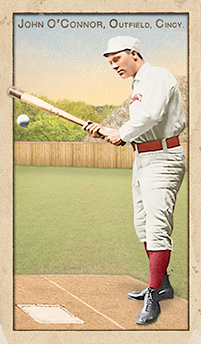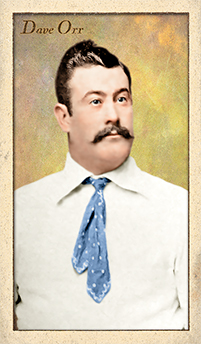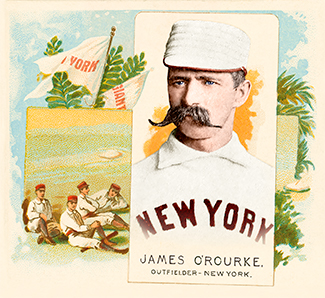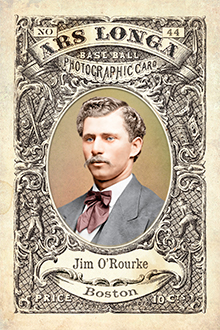
- Series: Beginnings: 1880's
- City: Cincinnati
- Team: Red Stockings (AA)
- League: American Association
John Joseph O’Connor (1866-1937) was as durable as they come. He holds the distinction, with a mere 28 others, of playing in four different decades in the majors. His durability was a product of his toughness. Despite the benign-sounding nickname of “Peach Pie,” O’Connor was known as one of the dirtiest players of his day and hard as nails. He excelled behind the plate, a position that devoured its occupants. With the Cleveland Spiders from 1892-98, O’Connor (also known as “Rowdy Jack”) hit .290+ four straight seasons. In his 21-year big league career, Jack hit a fine .263 He had started out with Cincinnati’s Red Stockings in 1887 and stayed in the Buckeye State with the Columbus Solons and Cleveland until he moved to St. Louis following the ‘98 campaign. He would move on to Pittsburgh and New York before landing back in St. Louis in 1904 where he remained through 1910.
Jack's waning days in St. Louis proved fateful for he and two of the game's all-time great hitters. Nap Lajoie and Ty Cobb were locked in a memorable duel for the batting title (and thus, the 1910 Chalmers Award) as the season wound down. O’Connor was the player/manager of the Browns when Lajoie’s Naps came to town for a season-ending double-header at Sportsman’s Park. History doesn’t record why O’Connor so strongly preferred Nap to win the title, but we might suppose Cobb wasn’t any more beloved in St. Louis than elsewhere. In any event, “Peach Pie” ordered his rookie third baseman Red Corriden to play back . . . way back, as in short left field. Lajoie proceeded to drop five bunts down the line, all for base hits. Lajoie reached base on his 6th at bat on a fielder's error, but O'Connor tried to bribe the official scorer to change the error to a hit, even offering to buy the woman a new wardrobe. The batting title and Chalmers Award went to Cobb despite the host’s accommodation. The difference in final average was minute, and the controversy inspired Chalmers to give both Lajoie and Cobb new cars. But the escapade cost O’Connor his job as league president Ban Johnson ordered him and Browns' owner Robert Hedges fired and banned. Decades later, research found Cobb had been double-credited with one day’s results. In 1981 Lajoie was declared the true winner of the batting title for 1910, by seven thousandths of a point. Rowdy Jack’s revenge….
- O'Connor's stunt got him blacklisted and unofficially banned from major league baseball for life
- At age 46, Jack returned to Cleveland’s Forest City club in 1912 for a last hurrah. No data survives for that team’s year but Baseball Reference records O’Connor managed the squad

- Series: Beginnings: 1880's
- City: Omaha
- Team: Omahogs
- League: Western Association
Patrick H. O’Connell (1861-1943) had a very short-lived experience in the majors. He played mostly outfield during part of the 1886 season for the Baltimore Orioles of the American Association. He started 41 of his 42 games in the field, played one at first base and relieved for three innings in a game. His woeful batting (.181 average) was eclipsed by his even more inept play in the pastures as he committed 17 errors on 78 chances. By contrast, Jumbo Davis, the third baseman, handled 231 plays and muffed only 35 at the hot corner. O’Connell’s path crossed with Sandy Nava in his last appearance in the majors that season. Nava was the first known Mexican-American to play in the big leagues and was closing out what had been primarily a National League career.
Pat had broken in with Lawrence of the Eastern New England League in 1885. The Maine native continued briefly with Lawrence the next year before going back closer to home in Portland prior to making the jump to the AA later in ‘86. O’Connell found more playing time out west. He moved to Oshkosh in the Northwestern League for the ‘87 season and saw the most action of his pro career. He played regularly at first base and hit a resounding .354 in 116 games. From Wisconsin, Pat’s playing career declined quickly. He got into 84 games with the Omaha Omahogs in ‘88 and fewer than half that for two clubs the next year. After several years absence, Pat resurfaced in 1895 with the New Bedford Whalers of the New England League. At 34 he was the old man on the club.
- The Old Judge production department oftentimes misidentified Pat O'Connell on his cards as being a member of the Des Moines Prohibitionists of the Western League, occasionally listing his name as "Connell." A Peter J. Connell did play for Des Moines that year, and is one of 39 subjects who make a one pose appearance in the Old Judge cannon. (Mike Dorgan, by contrast, singularly leads the OJ cohort with 17 different poses.) Because of the confusion, this Pat O'Connell is oftentimes cited as PJ O'Connell. Such mix-ups are fairly common in the OJ series as the intrepid Old Judge crew sought to document as many players as possible in an era of shoddy record-keeping.
- Series: 1888 Champion New York Giants
- City: New York
- Team: Giants
- League: National League
- Hall: National Baseball Hall of Fame
James Henry O’Rourke (1850-1919) made the National League’s first base hit, and went on to a 21-year, Hall of Fame career. From 1876-92, only Cap Anson played in more games or got more hits. After leaving MLB for the minors, O’Rourke returned for his swan song with his pal John McGraw’s Giants, becoming the oldest player (at 54) to play in the NL and to get a hit.
- Played for 5 pennant winners and was NA HR champ in 1874-75
- One of only 29 to play in MLB in four decades
- Entered the HOF as one of the first 19th Century players to do so
- Elected to Hall of Fame: 1945
- Series: Pioneer Portraits I: 1850-1874
- City: Boston
- Team: Red Stockings (NAPBBP)
- League: National Association (NAPBBP)
- Hall: National Baseball Hall of Fame
James Henry O’Rourke (1850-1919) made the National League’s first base hit, and went on to a 21-year, Hall of Fame career. From 1876-92, only Cap Anson played in more games or got more hits. After leaving MLB for the minors, O’Rourke returned for his swan song with his pal John McGraw’s Giants, becoming the oldest player (at 54) to play in the NL and to get a hit.
- Played for 5 pennant winners and was NA HR champ in 1874-75
- One of only 29 to play in MLB in four decades
- One of the first 19th century players to be elected to HOF
- Elected to Hall of Fame: 1945

- Series: 1880s: Spotted Ties
- City: New York
- Team: Metropolitans
- League: American Association
David L. Orr (1859-1915). A 1st baseman for 5 teams over 7 major league seasons, Orr was one of the best hitters of the 1880s. Largely forgotten today, Orr may have made a case for the Hall of Fame were it not for a career-ending, paralyzing stroke suffered on the field in 1890. Dave’s .342 lifetime average is 11th all-time & in 4 of 7 seasons, his closest comp is Dan Brouthers.
Brouthers himself believed Orr was the greatest hitter of his time:
"The greatest hitter that ever played ball was old Dave Orr. He didn't care whether they were over the plate or not. If they were within reach of that long bat of his he would hit them out, and when he hit them there was no telling whether they would be found again or not. I have always held that Dave Orr was the strongest and best hitter that ever played ball." - Dan Brouthers, Sporting Life, 1894
- Won AA batting title: 1884
- Won AA RBI crown: 1884
- Lead AA in hits: 1884 & 1886
- Lead AA in triples: 1885 & 1886
Auction History
Cartophilia
Old Judge Pose: 360-1




